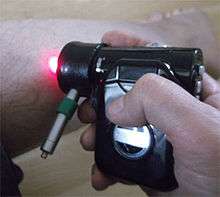Intelligent laser speckle classification

Intelligent laser speckle classification, or ILSC, is a scanning method used to discriminate between various micro-textural structures, such as the cellular components in human skin.[1]
Basic concept
An ILSC scanner is composed mainly of two instruments: A laser and a modified CCD camera.

Light from the laser interacts uniquely with various micro-textural structures, creating a specific laser speckle effect (or signature). This signature can then be read by the incorporated camera, which utilizes Bayesian inference and inbuilt libraries of micro-textures to create a "laser speckle image" of the target.[2] Since the method is comparative, it may also be used to differentiate very small changes in micro-structural objects, for example, a change in cell size. This ability to generate "comparative" laser speckle images is again due to the interactions between the laser and the cellular objects.[3]
Applications
The concept has been found to be very effective in analyzing human skin for issues caused by ageing, especially in the lower layers of the epidermis, such as the basal layer, and has also been found to be less invasive than other methods, such as confocal microscopy.[4]
References
- ↑ "Noninvasive Imaging Method Promising for Skin Assessment". Photonics. Retrieved 13 March 2015.
- ↑ "Laser Doppler, speckle and related techniques for blood perfusion mapping and imaging". Kingston University. Retrieved 13 March 2015.
- ↑ Orun, A.B, E. Goodyer, H.Seker, G. Smith, V.Uslan And D. Chauhan, “Optimized parametric skin modelling for diagnosis of skin abnormalities by combining light back-scatter and laser speckle imaging”, Skin Research and Technology, 2014; 1-13. doi:10.1111/srt.12142
- ↑ Orun, Ahmet. "An improvement of skin aging assessment by non-invasive laser speckle effect: A comparative texture analysis". De Montfort University. Retrieved 13 March 2015.